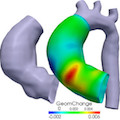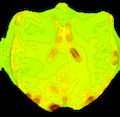Quantitative Biomedicine deals with the modeling, analysis, simulation, or optimization of various highly relevant processes in clinical practice. Not only the modeling of cellular, biochemical, and biomolecular processes, but also applications in medical engineering, such as the modeling, simulation, and optimization of prostheses or contributions to the area of imaging diagnostics, are enormously important.
At WIAS, mainly mathematical models for a better understanding of haemodynamic processes are developed, analyzed, and simulated. These models are then employed for the prognosis or optimization after medical interventions, using, e.g., model reduction and optimization techniques with partial differential equations. Other foci are the modeling and analysis of time-based systems, for example in cartilage reconstruction, calcium release, or medical image and signal processing. In the latter, classical tasks of image processing like registration, denoising, equalization, and segmentation, but also (low-rank - sparse) data decomposition and functional correlations, e.g., in neurological processes, are studied. These processes typically lead to complex, nonlinear, or nonsmooth inverse problems where often also statistical problems play a central part.

Modeling, Simulation and Optimization for Biomedical Applications
Today, in medical science digital simulation instruments for processes in the human body are utilized in diagnistics and therapy planning. At WIAS, models for biological tissues, fluids, and their interaction as well as techniques in optimization and optimal control for decision support in biomedicin are devloped.

Medical imaging and neuroscientific applications
Image processing tools based on mathematical algorithms from statistics or variational methods enable a bulk of applications in the medical sciences. They range from image enhancement to automatic image analysis.


